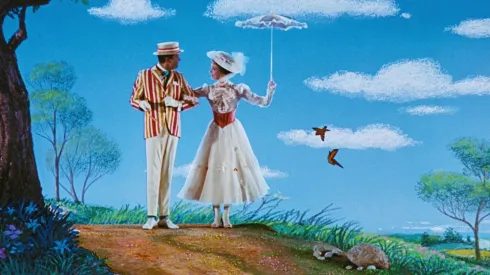Today marks the anniversary of “Mary Poppins,” the beloved film that has enchanted audiences for generations with its music, whimsy, and unforgettable performances. With soaring melodies in its soundtrack and dazzling visual effects that brought a magical nanny to life, this movie remains a timeless classic that continues to capture hearts around the world.
To honor this special day, we’re taking a closer look behind the scenes. Casting secrets, surprising production challenges, and groundbreaking filmmaking techniques all contributed to creating the magic of “Mary Poppins,” and here are 10 fascinating facts that reveal how this cinematic treasure came to life.
Julie Andrews: A Star Picked for Magic

Source: IMDb
Walt Disney discovered Dame Julie Andrews while she was dazzling audiences in “Camelot” on Broadway and immediately knew she was the perfect Mary Poppins. When she revealed she was expecting, Disney didn’t rush her—he offered to delay filming and even brought her husband, Tony Walton, on board to design costumes and some sets.
To help them feel at home, the couple received a private tour of Disneyland and Disney studios. Andrews’ charm left such an impression that animators later modeled Anita from One Hundred and One Dalmatians after her.
The Snowglobe That Almost Got Lost

Source: IMDb
The iconic “Mary Poppins” snowglobe, with birds circling Saint Paul’s Cathedral, almost vanished into obscurity. While searching for it, Dave Smith, the founder of the Walt Disney Archives, discovered it tucked away on a janitor’s office shelf.
The janitor had rescued it from the trash, thinking it was too beautiful to discard. Thanks to his careful keeping, this tiny piece of movie magic survived to become a cherished artifact.
A Crowning Achievement for Disney

Source: IMDb
Walt Disney held “Mary Poppins” in the highest regard, seeing it as one of the greatest accomplishments of his career. The film blended live-action, animation, music, and storytelling in ways that pushed the boundaries of cinema at the time. For Disney, it represented the perfect fusion of creativity and innovation that he had always dreamed of achieving.
A Spoonful of Inspiration

Source: IMDb
Lyricist Robert B. Sherman struggled for nearly two weeks to find the perfect phrase that could become Mary Poppins’ signature song. Inspiration struck unexpectedly when his young son Jeff described taking a polio vaccine on a cube of sugar. Robert immediately shared the idea with his brother, Richard, who set it to music the very next morning. That simple moment gave birth to the timeless classic, “A Spoonful of Sugar.”
Julie Andrews’ Favorite Kept Song

Source: IMDb
Dame Julie Andrews had a special fondness for the song “Stay Awake.” When she learned there were plans to cut it, she took matters into her own hands and wrote a letter to P.L. Travers expressing her concern. Travers agreed immediately, insisting the song stay in the film. Thanks to Andrews’ advocacy, audiences got to enjoy one of the movie’s most tender and memorable moments.
Disney’s Record-Breaking Night at the Oscars

Source: IMDb
“Mary Poppins” swept the Academy Awards, winning five out of its thirteen nominations and giving Walt Disney his most successful night ever at the Oscars. No other Disney film has matched that level of recognition in a single evening. The wins celebrated everything from acting and music to visual effects, highlighting the picture’s extraordinary craftsmanship.
No Romance Allowed

Source: IMDb
Author P.L. Travers insisted that Mary Poppins and Bert should never be portrayed as a romantic pair. The filmmakers honored her wishes, making sure the story focused on magic, adventure, and family rather than love. This boundary is even referenced in the song “Jolly Holiday,” keeping the relationship purely whimsical and friendly.
Dick Van Dyke’s Humble Reflection

Source: IMDb
Dick Van Dyke regards “Mary Poppins” as the finest film of his career, yet he has admitted he felt somewhat miscast as Bert. Over the years, he has suggested that actors like Jim Dale or Ron Moody might have been a better fit for the role. Despite his self-doubt, Van Dyke’s performance remains iconic, bringing charm, energy, and memorable dance numbers to the screen.
Matthew Garber’s Tea Party Earnings

Source: IMDb
Young actor Matthew Garber was paid just ten cents for each take of the iconic tea party scene. Since he was afraid of heights, the crew sweetened the deal with a “bonus” of ten cents per take to help him face the challenge. His courage and persistence helped bring one of the film’s most memorable and whimsical sequences to life.
Disney Returns to the Premiere Spotlight

Source: IMDb
Before the 1964 debut of Mary Poppins, Walt Disney hadn’t attended a studio premiere in nearly three decades, his last being Snow White and the Seven Dwarfs in 1937. His presence at this premiere highlighted just how special the film was to him. Disney’s attendance added extra excitement and grandeur to the event, underscoring the movie’s significance in his career.





